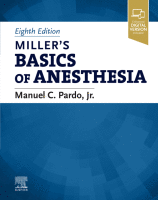Physical Address
304 North Cardinal St.
Dorchester Center, MA 02124

The postanesthesia care unit (PACU) is managed by anesthesiologists, who provide general medical supervision and coordination of patient care. Historically, PACUs did not become a standard part of hospital design until the late 1940s, after an influential study of mortality…

Procedures performed outside the operating room (OR) fall under the term nonoperating room anesthesia (NORA), which refers to providing anesthesia care at any location away from traditional OR suites ( Box 38.1 ). In response to the need for minimally…

INTRODUCTION Ambulatory anesthesia is a rapidly growing field involving three distinct entities: outpatient anesthesia (the primary focus of this chapter), office-based anesthesia (OBA), and non–operating room anesthesia (NORA) (also see Chapter 38 ). The idea of outpatient anesthesia started over…

Patients waiting for a transplantable organ share a hope for the future that is predicated on the availability of an organ donor. Donor death must be declared before organ procurement. Donation after brain death (DBD) is the most common setting…

INTRODUCTION The proportion of the U.S. population over the age of 65 continues to grow ( Fig. 35.1 ). This segment of the population is expected to double between the years 2020 and 2060, and the number of people aged…

Providing anesthetic care for infants and children poses unique challenges because of the profound differences in physiology, pharmacokinetics and pharmacodynamics of anesthetic drugs, and wide variety of procedures that these patients undergo, which are often very different from the adult…

# Providing peripartum analgesia and anesthesia requires an understanding of the physiologic changes that occur during pregnancy and labor and the effects of anesthetic care on the mother, fetus, and neonate. It also demands an understanding of the course of…

RHEUMATOLOGIC DISORDERS Patients with rheumatoid arthritis (RA) and other rheumatologic disorders, such as ankylosing spondylitis, present for orthopedic surgery related to their disease state. Knowledge of these diseases and their underlying medical issues is essential for optimal anesthetic and perioperative…

Surgical procedures of the head and neck present unique anesthetic challenges. Operative field isolation places the anesthesia provider at a distance from the airway and hampers access to the patient. The region's extensive parasympathetic innervations predispose patients to intraoperative bradycardia…

The central nervous system (CNS) deserves special consideration in the perioperative setting for several reasons. First, anesthesia care is often required for patients undergoing treatment for CNS diseases, such as intracranial tumors or aneurysms, carotid disease, or diseases of the…